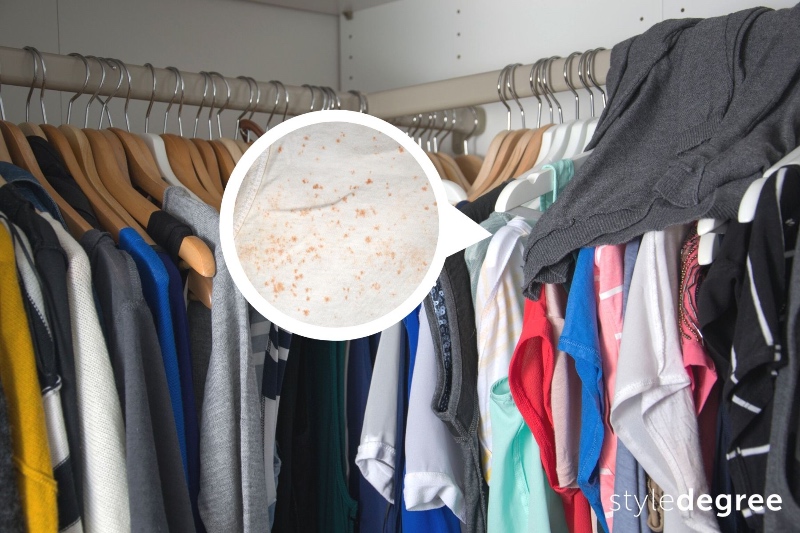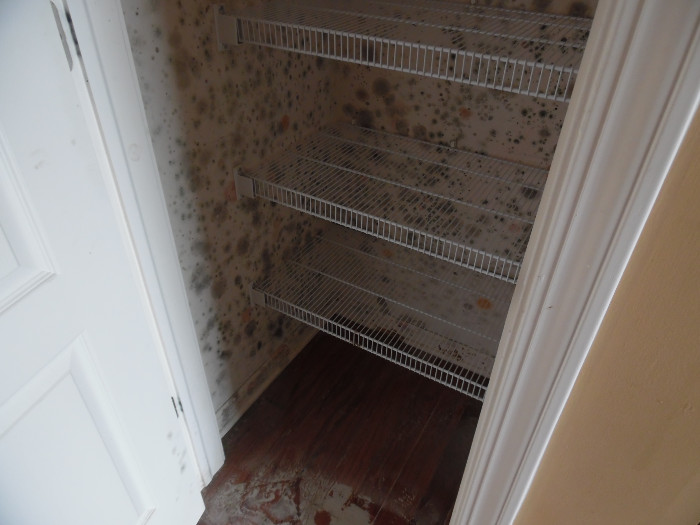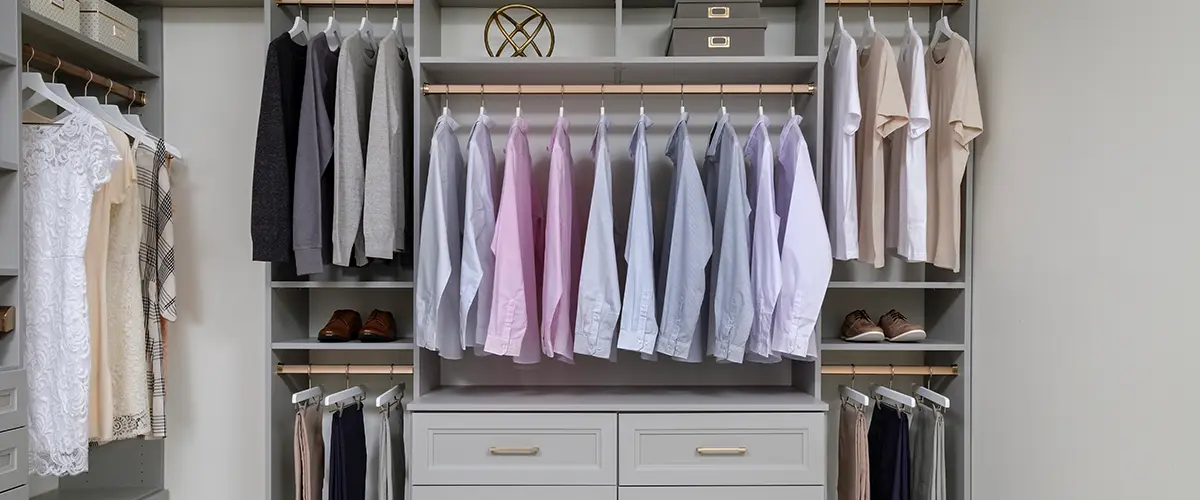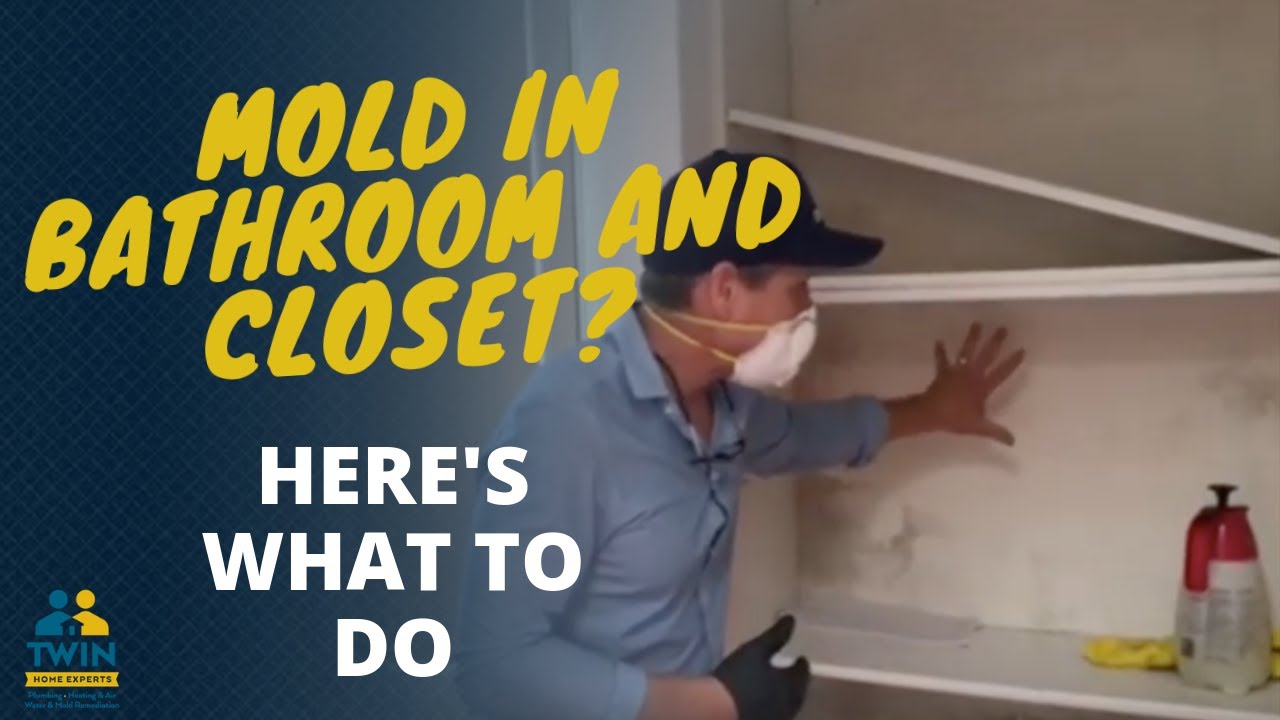To get rid of mildew in the closet, start by removing all items, then clean the affected area with a solution of water and vinegar. Ensure the closet is dry and well-ventilated.
Dealing with mildew in the closet can be a frustrating and persistent issue. The presence of mildew not only damages clothes and other items but also poses health risks. However, with the right approach, you can effectively eliminate mildew and prevent its return.
In this guide, we will explore simple and practical methods to get rid of mildew in your closet and keep it mold-free. By following these steps, you can ensure a clean, fresh, and healthy closet environment for your belongings.
Common Causes Of Mildew
Mildew in closets can result from excessive moisture, poor ventilation, or damp fabrics. To eliminate it, start by thoroughly cleaning and drying the affected area. Use a mixture of water and vinegar or hydrogen peroxide to scrub the mildew, and ensure the closet remains well-ventilated to prevent its return.
Excess Moisture
Excess moisture is the primary cause of mildew in closets. It can result from leaks, high humidity levels, or damp clothing. Reducing moisture is key to preventing mildew growth.Poor Ventilation
Inadequate airflow contributes to mildew development in closets. Stagnant air traps moisture and encourages mildew growth. Improving ventilation helps keep closets dry and mildew-free. Remember: Regularly monitoring moisture levels and maintaining proper ventilation are crucial in preventing mildew in closets. Table: | Causes of Mildew | |———————————–| | Excess Moisture | | Poor Ventilation | | Leaks | | High Humidity Levels | | Damp Clothing | | Inadequate Airflow | | Stagnant Air | | Lack of Proper Ventilation |Identifying Mildew In The Closet
Musty Odor
If you notice a musty odor emanating from your closet, it might indicate the presence of mildew. Mold and mildew have a distinct, unpleasant scent that can help in identifying their existence.
Visible Spots Or Stains
Visible spots or stains on walls, clothes, or other surfaces within the closet can be a clear sign of mildew growth. These spots may appear black, green, or greyish in color, indicating the presence of mold.
Preventing Mildew In The Closet
Prevent mildew in your closet with these easy tips. Eliminate moisture, improve air circulation, and keep clothing dry to discourage mildew growth.
Use Dehumidifiers
One effective way to prevent mildew from developing in your closet is by using dehumidifiers. Dehumidifiers are devices designed to remove excess moisture from the air, creating a dry environment that is inhospitable to mildew growth. By controlling the humidity levels in your closet, you can significantly reduce the chances of mildew taking hold.
Dehumidifiers work by extracting moisture from the air and collecting it in a container or draining it through a hose. They are available in various types and sizes to suit different spaces and needs. When using a dehumidifier in your closet, ensure that it is adequately sized to handle the size of the space. Place the dehumidifier near the affected area, ideally at the lowest point, to maximize its effectiveness.
Install Ventilation
In addition to using dehumidifiers, proper ventilation is crucial for preventing mildew growth in your closet. Adequate airflow helps to keep the air circulating, reducing moisture buildup and creating an environment that is less favorable for mildew.
Consider installing a ventilation system in your closet, such as a small exhaust fan or a vent. These systems help to remove moist air and bring in fresh air from outside. If installing a ventilation system is not feasible, you can also improve natural airflow by keeping the closet door open for a period each day. This allows air to circulate and helps to prevent the buildup of humidity.
Keep Closet Well-organized
Maintaining a well-organized closet can also contribute to preventing mildew. Clutter and overcrowding can restrict airflow and create pockets of stagnant air, providing an ideal breeding ground for mildew.
Start by decluttering your closet and removing any items you no longer need or use. Maximize the space by using shelves, storage bins, and hanging organizers to keep your belongings organized and off the floor. Avoid overstuffing the closet, as this can hinder proper airflow. Leave sufficient space between items to allow air to circulate freely.
Regularly clean and dust your closet to prevent the accumulation of debris and moisture-retaining particles. Use a mild detergent or a mixture of vinegar and water to wipe down surfaces, and ensure that the closet is completely dry before returning the items. Consider using moisture-absorbing products, such as silica gel packets or activated charcoal, to help control humidity levels within the closet.
By following these preventive measures, you can minimize the risk of mildew in your closet, ensuring that your belongings remain clean, fresh, and mildew-free.

Credit: styledegree.sg
Removing Mildew From Closet
Mildew in the closet can be a pesky problem, but it is not impossible to conquer. By following a few simple steps, you can remove mildew from your closet and prevent it from coming back. Here’s how:
Remove Affected Items
Begin by removing all items from the closet that have been affected by mildew. Clothing, shoes, and any other items should be taken out and inspected for signs of mildew.
If any items are found to have mildew, they should be washed or professionally cleaned to remove the mildew spores and prevent the problem from spreading.
Clean With Vinegar Or Bleach
After removing the affected items, it’s time to clean the closet itself. A solution of white vinegar and water or a mixture of bleach and water can be used to scrub the surfaces where mildew is present.
Be sure to wear gloves and a mask while cleaning to protect yourself from the fumes of the cleaning agents. After cleaning, allow the closet to air out and dry thoroughly.
Dry The Closet
It is essential to ensure that the closet is completely dry before returning any items to it. Use fans, dehumidifiers, or open windows to help dry out the closet thoroughly.
Inspect the closet regularly to make sure that the mildew does not make a reappearance, and if it does, repeat the cleaning process as necessary.
Natural Remedies For Mildew Removal
Mildew in the closet can be a common problem, especially in spaces with high humidity. The good news is that there are natural remedies for mildew removal that are effective and safe. These remedies can help get rid of mildew in your closet without the need for harsh chemicals, leaving your clothes and belongings mold-free and fresh.
Tea Tree Oil
Tea tree oil is a powerful natural antifungal agent that can help eliminate mildew in your closet. Its strong scent not only helps in eliminating the musty odor but also prevents mildew from coming back. To use tea tree oil, mix a teaspoon of it with a cup of water in a spray bottle. Spray the affected areas of your closet and let it sit for a few hours before wiping it clean with a damp cloth. For heavily affected areas, you can also place a few drops of tea tree oil on a cotton ball and leave it in the closet to combat mildew.
Baking Soda
Baking soda is another effective natural remedy for mildew removal in your closet. Its absorbent and deodorizing properties make it an excellent choice for eliminating moisture and musty odors. To use baking soda, sprinkle it generously on the affected areas of your closet and allow it to sit for a few hours. Afterward, use a brush or vacuum to remove the baking soda, and then wipe the area clean with a damp cloth. Baking soda can also be used in open containers placed inside your closet to absorb excess moisture and prevent mildew growth.

Credit: advantaclean.com
Preventing Mildew Re-growth
Mildew in your closet can be a nuisance, causing an unpleasant odor and damaging your clothes. That’s why it’s essential to not only get rid of existing mildew but also take steps to prevent it from re-growing. By following a few simple strategies, you can keep your closet clean, fresh, and free from mildew.
Proper Air Circulation
Ensuring proper air circulation in your closet is crucial in preventing mildew re-growth. Without adequate ventilation, moisture can accumulate, creating the perfect environment for mildew to thrive. Here’s how you can improve air circulation:
- Leave space between your clothes to promote air movement
- Install a small fan or dehumidifier to reduce humidity levels
- Place silica gel or activated charcoal sachets inside your closet to absorb excess moisture
Regular Cleaning And Maintenance
Maintaining a clean and well-maintained closet is another effective way to prevent mildew re-growth. Regular cleaning eliminates any existing spores and prevents them from spreading. Here are some cleaning and maintenance tips:
- Remove all items from your closet and thoroughly clean the shelves and walls using a mixture of warm water and mild detergent
- After cleaning, ensure the closet is completely dry before returning your clothes
- Regularly inspect your closet for any signs of leaks or water damage. Repair any issues promptly to prevent moisture buildup
- Avoid storing wet or damp clothes in your closet. Always dry them completely before placing them back
Implementing these preventive measures will not only help you get rid of mildew but also keep it from coming back. By maintaining proper air circulation and practicing regular cleaning and maintenance, you can enjoy a fresh and mildew-free closet for years to come.
Mildew Prevention Tips For Different Closet Materials
In order to maintain the freshness of your clothes and prevent the growth of mildew in your closet, it is essential to follow mildew prevention tips for different closet materials.
Wooden Closets
Maintain proper ventilation by leaving the closet doors slightly open. Wipe down the interior with a mixture of vinegar and water.
Plastic Closets
Clean the closet regularly with a mild soap and water solution. Ensure proper airflow by not overstuffing the closet.
Fabric Closets
Use moisture absorbers like silica gel packets. Avoid storing damp or wet clothing in fabric closets to prevent mildew growth.
Calling Professional Help
Mold removal in closets can be tricky; if attempts to clean mildew in your closet have failed, it may be time to seek professional assistance.
When The Problem Persists
If mildew continues to appear after cleaning attempts, it’s wise to consult professionals for effective removal solutions.
Severe Mold Infestation
For cases of severe mold, especially black mold, immediate professional intervention is crucial to ensure safe and complete removal.

Credit: www.creativeclosetorganizers.com
Frequently Asked Questions For How To Get Rid Of Mildew In Closet
How Does Mildew Develop In Closets?
Mildew in closets develops due to high humidity and lack of ventilation. Condensation on walls and ceilings can also contribute to mildew growth.
What Are The Signs Of Mildew In A Closet?
Signs of mildew in a closet include a musty odor, visible black or gray spots on surfaces, and damp or discolored clothing and other items.
How To Prevent Mildew In Closets?
To prevent mildew in closets, ensure good ventilation, use a dehumidifier, keep the closet clean and dry, and use moisture-absorbing products like silica gel or activated charcoal.
What Are Effective Ways To Remove Mildew In A Closet?
To remove mildew in a closet, scrub affected surfaces with a solution of water and detergent, use a mildew cleaner, and ensure thorough drying of the area. Regular cleaning and maintenance are key.
Conclusion
To effectively tackle mildew in your closet, it’s essential to act swiftly using the right strategies. By eliminating excess moisture, improving ventilation, and utilizing natural remedies like vinegar and baking soda, you can successfully combat mildew growth. Regular cleaning and maintenance will also prevent its return, ensuring a fresh and mold-free environment for your clothes and belongings.
With these simple yet effective methods, you can bid farewell to mildew and enjoy a clean and odor-free closet.
{ “@context”: “https://schema.org”, “@type”: “FAQPage”, “mainEntity”: [ { “@type”: “Question”, “name”: “How does mildew develop in closets?”, “acceptedAnswer”: { “@type”: “Answer”, “text”: “Mildew in closets develops due to high humidity and lack of ventilation. Condensation on walls and ceilings can also contribute to mildew growth.” } } , { “@type”: “Question”, “name”: “What are the signs of mildew in a closet?”, “acceptedAnswer”: { “@type”: “Answer”, “text”: “Signs of mildew in a closet include a musty odor, visible black or gray spots on surfaces, and damp or discolored clothing and other items.” } } , { “@type”: “Question”, “name”: “How to prevent mildew in closets?”, “acceptedAnswer”: { “@type”: “Answer”, “text”: “To prevent mildew in closets, ensure good ventilation, use a dehumidifier, keep the closet clean and dry, and use moisture-absorbing products like silica gel or activated charcoal.” } } , { “@type”: “Question”, “name”: “What are effective ways to remove mildew in a closet?”, “acceptedAnswer”: { “@type”: “Answer”, “text”: “To remove mildew in a closet, scrub affected surfaces with a solution of water and detergent, use a mildew cleaner, and ensure thorough drying of the area. Regular cleaning and maintenance are key.” } } ] }

